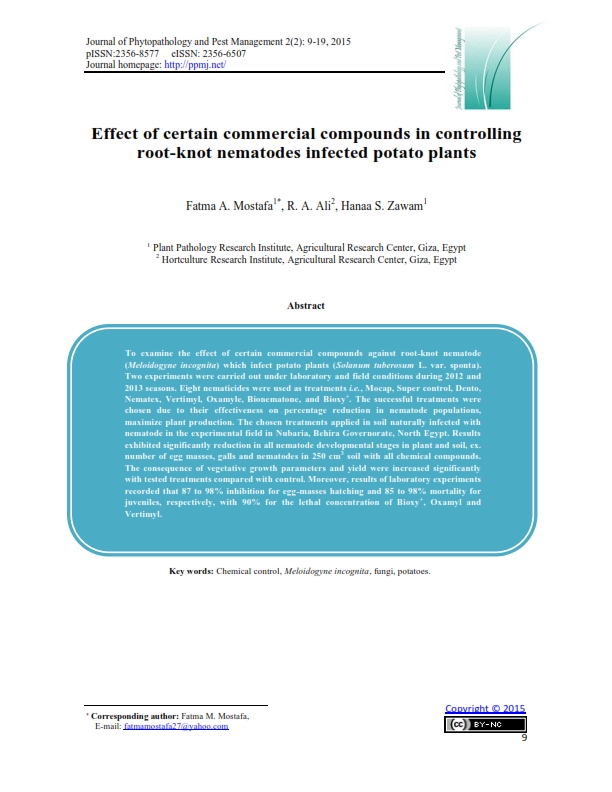Effect of certain commercial compounds in controlling root-knot nematodes infected potato plants
Keywords:
Chemical control, Meloidogyne incognita, fungi, potatoes,Abstract
To examine the effect of certain commercial compounds against root-knot nematode (Meloidogyne incognita) which infect potato plants (Solanum tuberosum L. var. sponta). Two experiments were carried out under laboratory and field conditions during 2012 and 2013 seasons. Eight nematicides were used as treatments i.e., Mocap, Super control, Dento, Nematex, Vertimyl, Oxamyle, Bionematone, and Bioxy+. The successful treatments were chosen due to their effectiveness on percentage reduction in nematode populations, maximize plant production. The chosen treatments applied in soil naturally infected with nematode in the experimental field in Nubaria, Behira Governorate, North Egypt. Results exhibited significantly reduction in all nematode developmental stages in plant and soil, ex. number of egg masses, galls and nematodes in 250 cm3 soil with all chemical compounds. The consequence of vegetative growth parameters and yield were increased significantly with tested treatments compared with control. Moreover, results of laboratory experiments recorded that 87 to 98% inhibition for egg-masses hatching and 85 to 98% mortality for juveniles, respectively, with 90% for the lethal concentration of Bioxy+, Oxamyl and Vertimyl.Metrics
Metrics Loading ...

Published
2015-05-27
How to Cite
Mostafa, F. A., Ali, R. A., & Zawam, H. S. (2015). Effect of certain commercial compounds in controlling root-knot nematodes infected potato plants. Journal of Phytopathology and Disease Management, 2(2), 9–19. Retrieved from https://ppmj.net/index.php/ppmj/article/view/26
Issue
Section
Research Articles
License
Authors who publish with Journal of Phytopathology and Disease Management agree to the following terms:
- Authors retain copyright and grant the journal right of first publication with the work simultaneously licensed under a Creative Commons Attribution License that allows others to share the work with an acknowledgement of the work's authorship and initial publication in this journal.
- Authors retain copyright and grant the journal right of first publication with the work simultaneously licensed under the Creative Commons Attribution-Non Commercial License (CC BY-NC). This allows others to share the work with an acknowledgement of the work's authorship and initial publication in this journal.
- Archives of Agricultural Sciences Journal is an Open Access Journal, and articles published are distributed under the terms of the Creative Commons Attribution-Non Commercial License (CC BY-NC). Readers may copy, distribute, and display the work for non commercial purposes with the proper citation of the original work. However, the journal retains the right to exploit subsidiary rights on behalf of the authors.
- Authors are able to enter into separate, additional contractural arrangements for the non-exclusive distribution of the journal's published version of the work (e.g. post it to an institutional repository or publish it in a book), with an acknowledgement of its initial publication in this journal.
- Authors are permitted and encouraged to post their work online (e.g., in institutional repositories or on their website) prior to and during the submission process with full disclosure to the journal, as it can lead to productive exchanges, as well as earlier and greater citation of published work. Following publication in Archives of Agricultural Sciences Journal, the author should update the repository, and include a citation and link to the published work.
Click here for more information on Licensing policy
.png)




